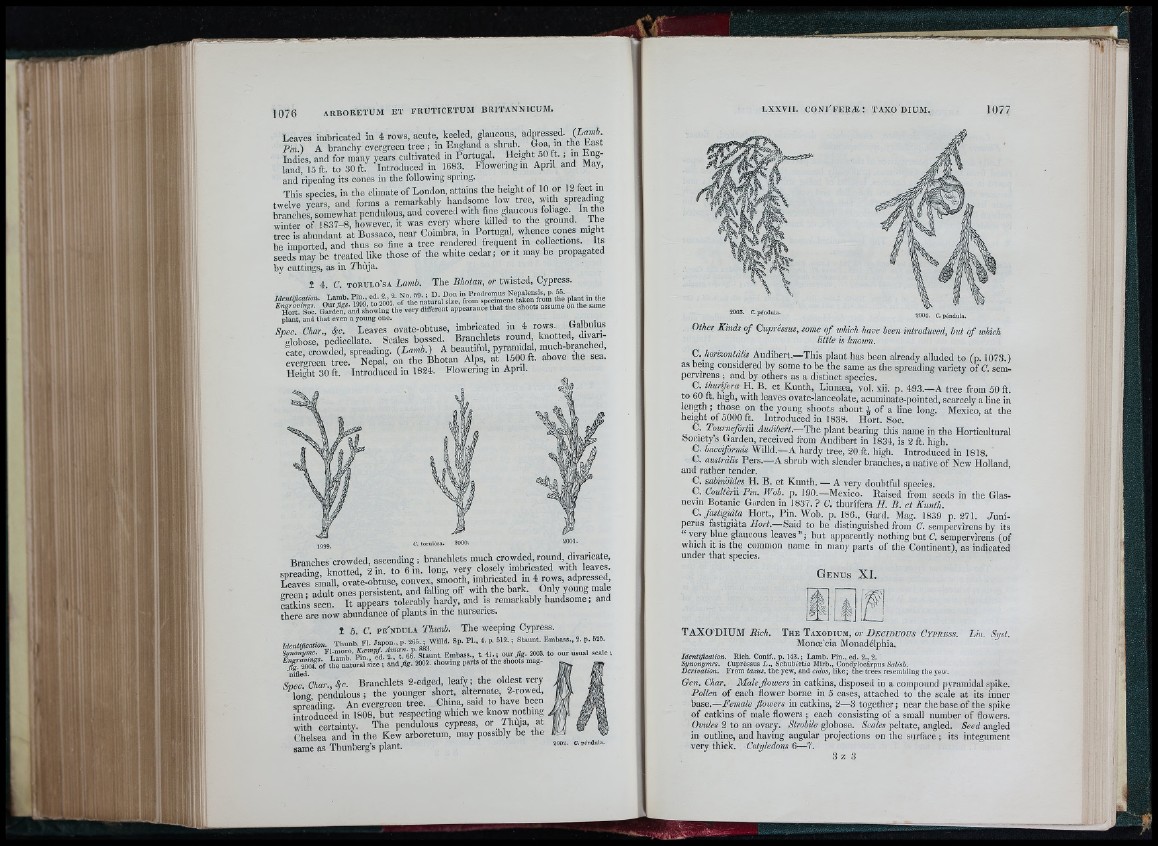
ARBORETUM ET FRUTICETUM BRITANNICUM.
Leaves imbricated in 4 rows, acute, keeled, glaucous
Pin 1 A branchy evergreen tree ; in England a shrub. Goa, in the b a st
Indies, and for many years cultivated in Portugal. Height 50 _ft. ; in England,
15 ft. to 30 ft. Introduced in 1683. Flowering ra April and May,
and ripening its cones in the following spring.
This species, in the climate of London, attmns the height o f 10 or 12 feet in
twelve years, and forms a remarkably handsome low tree, with spreading
b ran c h ? , somewhat pendulous, and covered with fine glancons foliage In the
winter of 1837-8, however, it was every where killed to the ground. The
tree is abundant at Bussaco, near Coimbra in
be imported, and thus so fine a tree rendered frequent in collections. Us
seeds Yay be treated like those of the white cedar; or it may be propagated
by cuttings, as in Thuja.
1 4 C. TORULo'sA Lamb. The Bhotan, or twisted, Cypi’ess.
MenttJicaUon. Pm - ^ Y l Pl™t in t l .,
i f r i r i J . G a Ä a S o w im g th e very different appearance th a t th e shoots assume on th e same
plant, and th a t even a young one.
Spec. Char., f r . Leaves ovate-obtuse, imbricated m 4 rows. Ga biilus
globose, pedicellate. Scales bossed. Branchlets round knotted dm m -
cate crowded spreading. (Lamh.) A beautiful, pyramidal, much-branched,
„ r t e r i ^ e p a i on the Bhotan Alps, at 1500 ft. above the sea.
Height 30 ft. Introduced in 1824. Flowering in April.
1999. C. torulòsa. 2000.
Branches crowded, ascending; branchlets much crowded, round, divaricate,
spreadinn, knotted, 2 in. to 6 in. long, very closely imbricated with leaves.
L e ? e s Iriall, ovate-obtnse, convex, smooth, imbricated in 4 rows, adpressed,
Y e ? ; adult ones persistent, and falling off with the bark. Only young male
ritk in s seen. I t appears tolerably hardy, and is remai-kably handsome; and
there are now abundance of plants in the nurseries.
i 5 C p e ' n d u l a Thunl. The weeping Cypress.
Mentilication. T h nnb Fl. Japon.. p. '165.; Willd. Sp. P L. 4. p. 512.; Staunt. Emhas*., 2. p . 525.
Sqnonyine. fiuqnl.-Emhass., t .4 1 . ; our * . 2003. to o u r— .A . c l - .
®%:TooA of th i « u m , “ ra d * . 2002. showing parts of t h , shoots mags
lT c h a r . , f r . Branchlets 2-edged, leafy; the oldest v e ij
1o!f, pendulous; the younger short, alternate 2-rowed,
spreading. An evergreen tree. China, said to have been
introduced in 1808, but respecting which we know nothing
with certainty. The pendulous cypress, or Thuja, at
Chelsea and in the Kew arboretum, may possibly be the
same as Thunberg's plant.
LXXVII. c o n i ' f e r æ : t a x o d i u m . 1 0 7 7
2003. C. p éndula. 2004. C. p éndula.
Other Kinds of Cupréssus, some of which have been introduced, but of which
little is Imcwn.
C. horizontàlis Audibert.—This plant has been already alluded to (p. 1073.)
as being considered by some to be the same as the spreading variety of C. sem-
pervirens -, and by others as a distinct species.
C. thunfera H. B. et Kunth, Linniea, vol. xii. p. 493.—A tree from 50 ft.
to 60 it. high, with leaves ovate-lanceolate, acuminate-pointed, scarcely a line in
length ; those on the young shoots about i of a line long. Mexico, at the
height o f 5000 ft. Introduced in 1838. Hort. Soc.
C. TournefóHü Audibert.— The plant bearing this name in the Horticultural
Society s Garden, received from Audibert in 1834, is 2 ft. high.
a bacáfórmis Willd.—A hardy tree, 20 ft. high. Introduced in 1818.
G. australis Pers.—A shrub with slender branches, a native of New Holland,
and rather tender.
C. sabinmdes H. B. et Kunth. — A very doubtful species.
C. CoultéÁi Pin. Wob. p. 190.—Mexic¿. Raised from seeds in the Glas-
nevin Botanic Garden in 1837. ? C. thurifera H. B. et Kunth.
C. fastigiàta Hort., Pin. Wob. p. 186., Gard. Mag. 1839 p. 271. J u n íperas
fastigiàta Said to be distinguished from C. sempervìrens by its
“ very blue glaucous leaves” ; but apparently nothing but C. sempervìrens (of
which it is the common name in many parts of tlie Continent), as indicated
under th a t species.
G e n u s X I .
I s
TA X O 'D IUM Rich. T h e T a x o d i u m , or Z lD C iD f /o r a C y p r e s s . Lin, S y s t .
Monoe'cia Monadélphia.
Identification. Rich. Conif., p. 143. ; Lamb. P in ., ed. 2., 2.
Synonymes. Cupréssus L ., Sohubért/a Mirb., Condylocârpus Salisb.
Derivation. From taxus, th e yew, and eidos, lik e ; th e trees resembling the yew.
Gen. Char. Male flowers in catkins, disposed in a compound pyramidal spike.
Pollen o f each flower borne in 5 cases, attached to the scale at its inner
base.—Female fiowers in catkins, 2— 3 together ; near the base o f the spike
of catkins of male flowers ; each consisting of a small number of flowers.
Ovules 2 to an ovary. Strobile globose. Scales peltate, angled. Seed angled
in outline, and having angular projections on the surface ; its integument
very thick. Cotyledons 6—7.